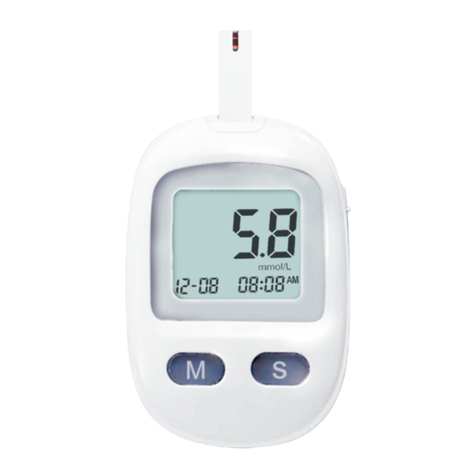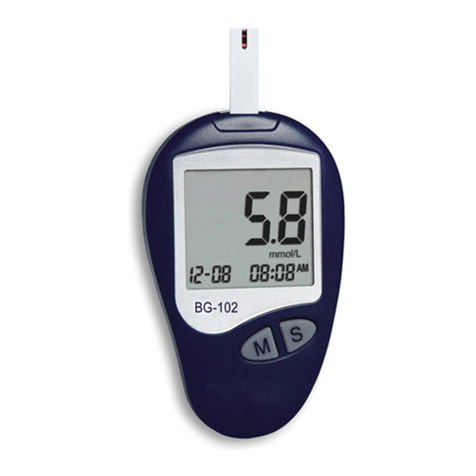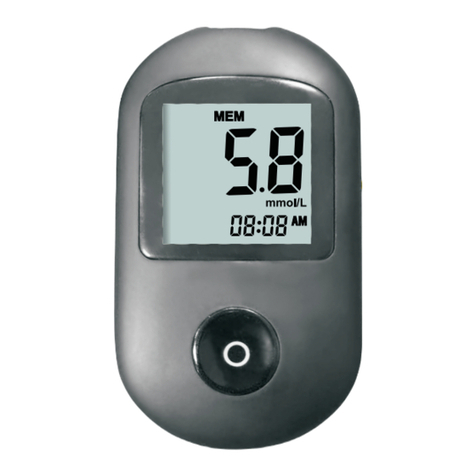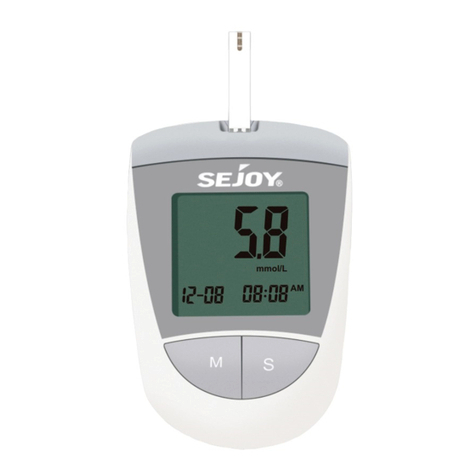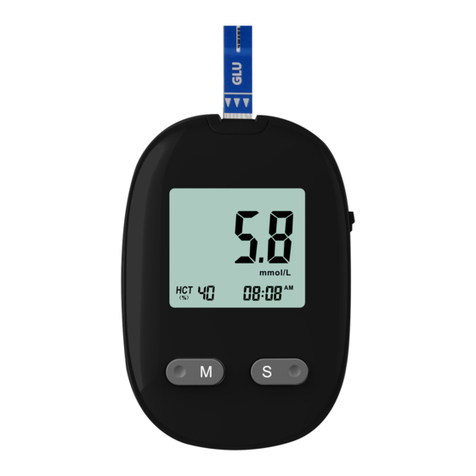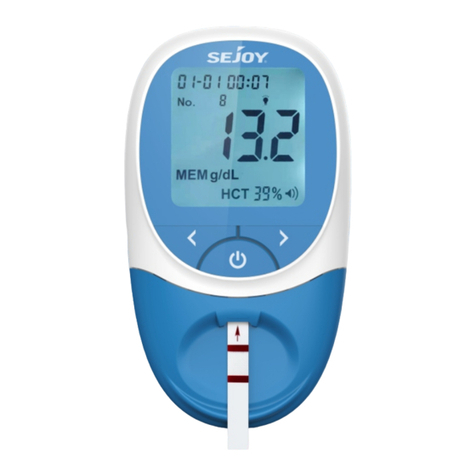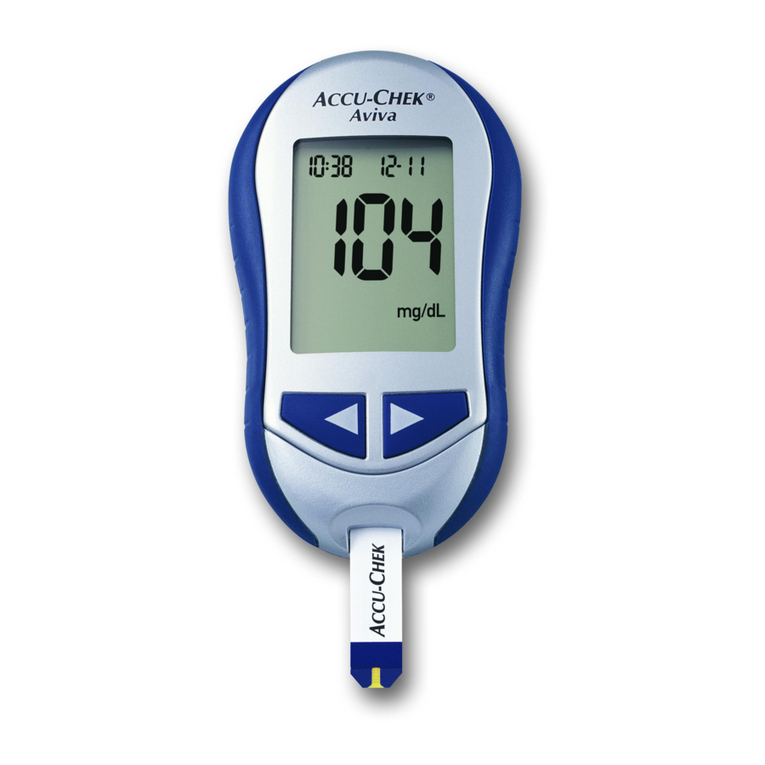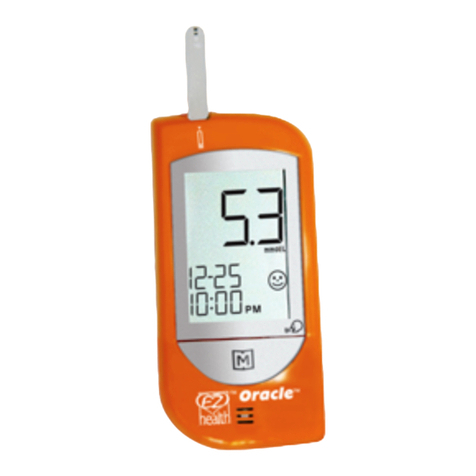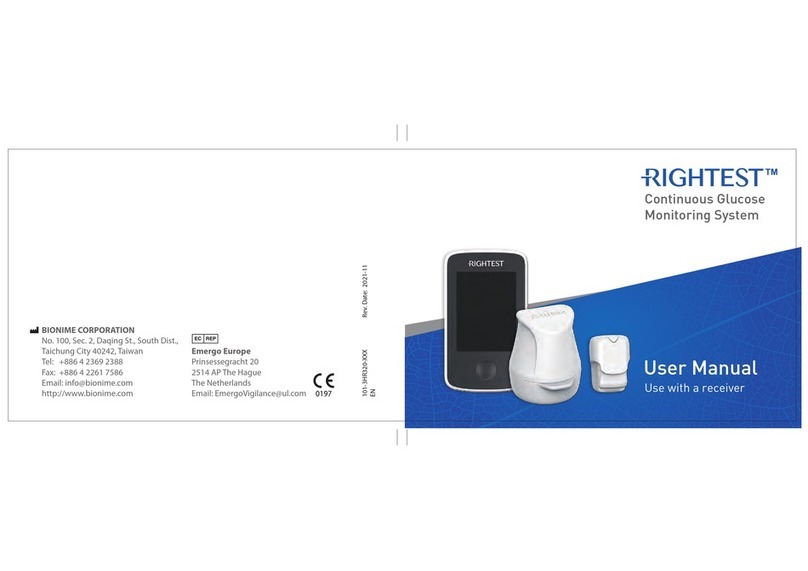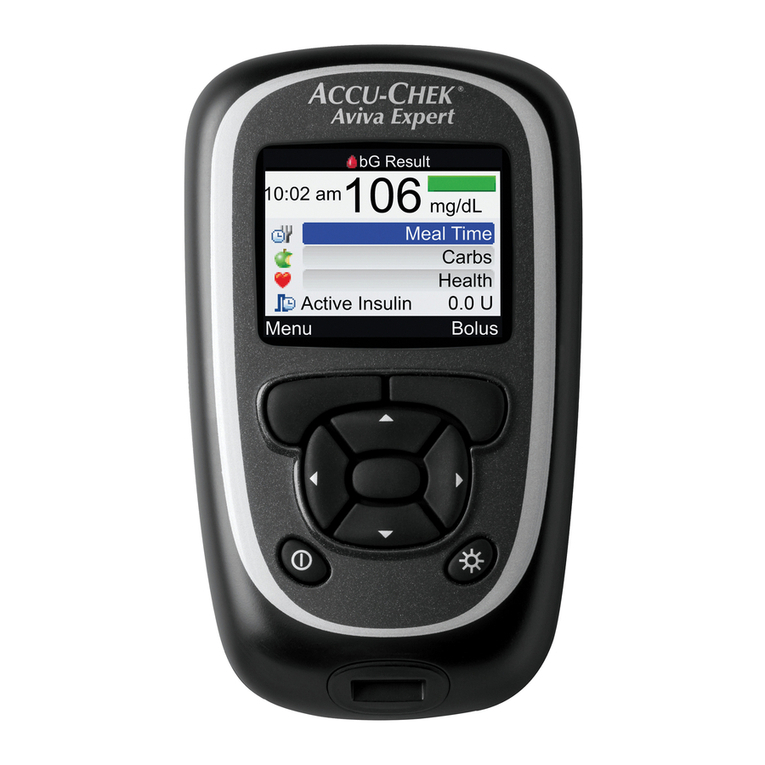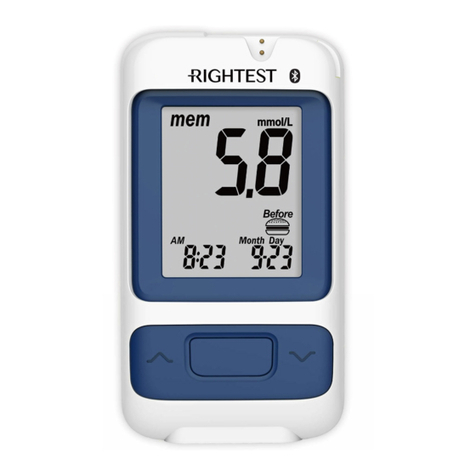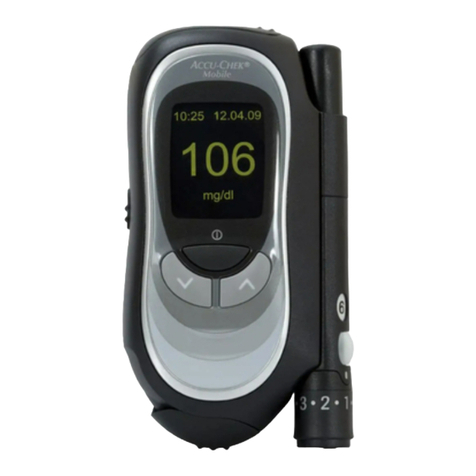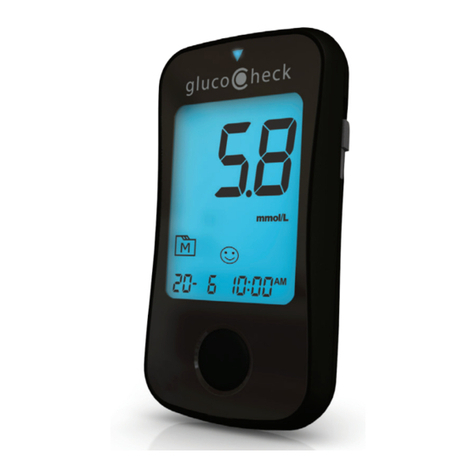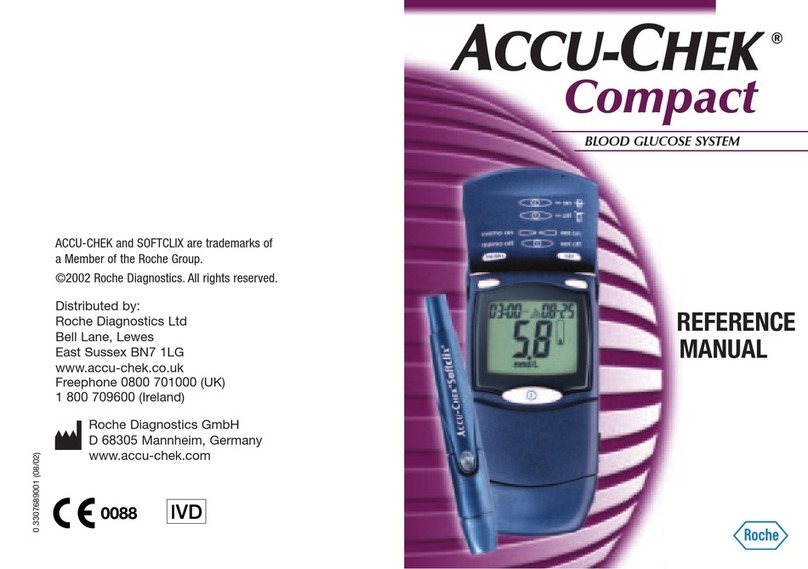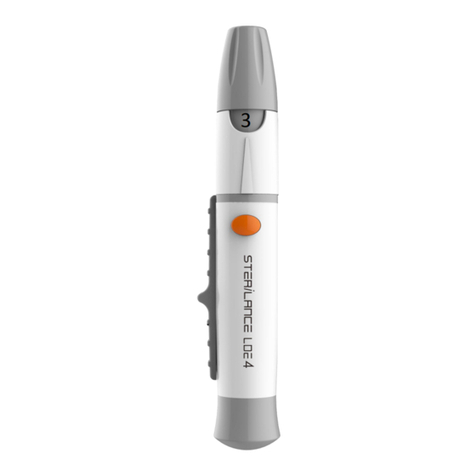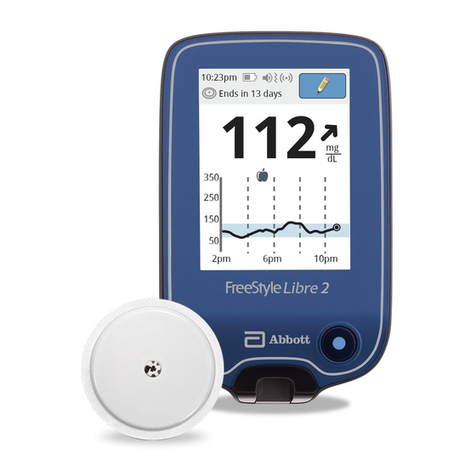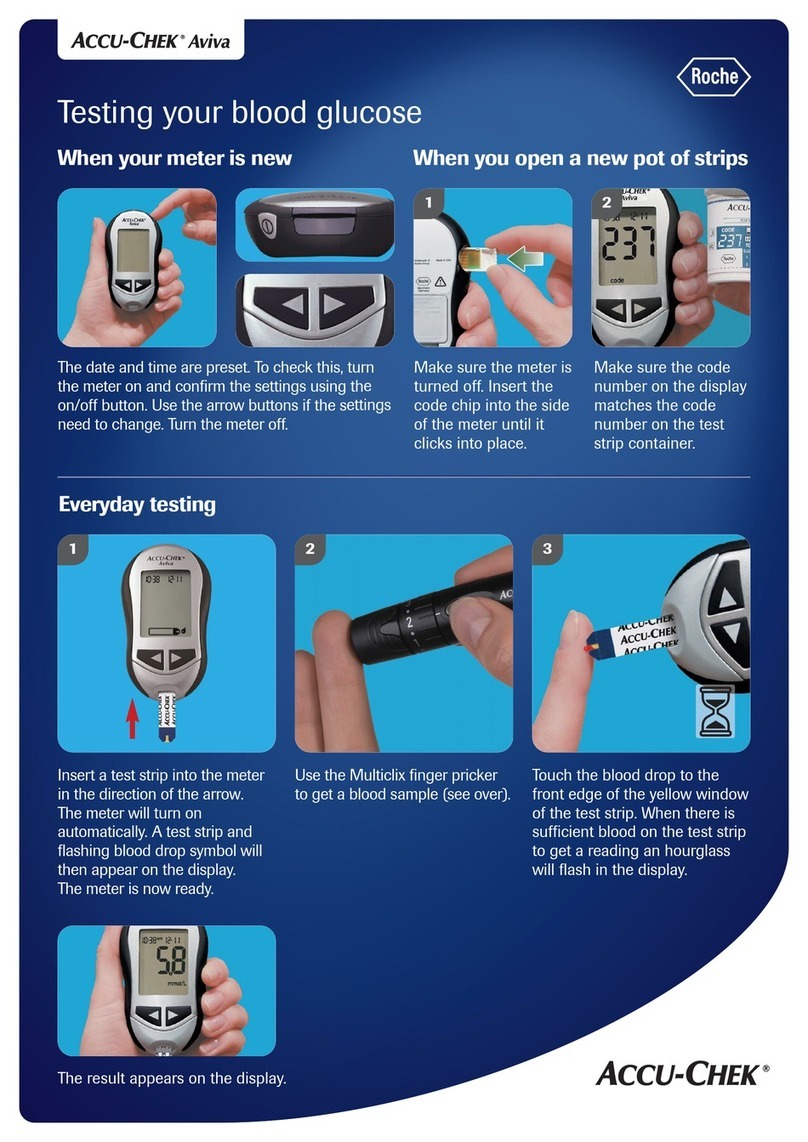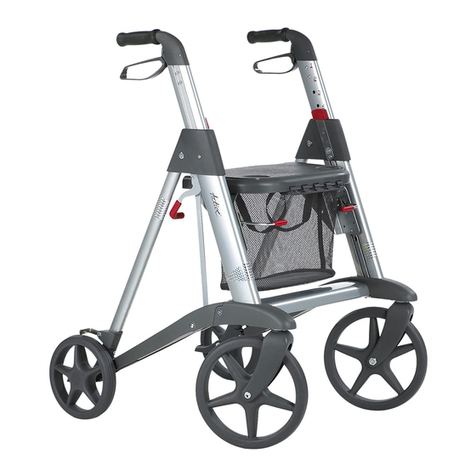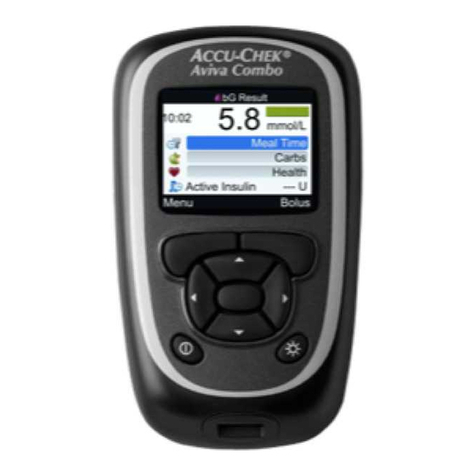Sejoy BG-210b User manual

Owner’s Booklet
BG-210b Blood Glucose Monitoring System
Advanced Diabetes Management System

Contents
Important Safety information ································
Important Health-Related information ···················
Meter (battery included) ····································
Test Strips ·····················································
Lancing Device ················································
Lancet ·························································
Control Solution ··············································
Setting the date and time ····································
Setting the measuring unit ·································
Setting the test reminder ····································
Bluetooth connection ·······································
Preparing the lancing device ································
Blood sampling ·················································
Testing ··························································
Interpreting unexpected test results ····················
When to perform a control test ····························
Performing a control test ···································
Understanding out-of-range control test results ········
Maintenance ······················································
Replacing the battery ······································
Introduction ························································
Getting to know your system ··································
Setting up your meter·············································
Testing your blood glucose ·····································
Memory and averages ··········································
Control solution testing ·········································
01
02
03
06
06
07
08
09
09
10
10
11
14
15
17
17
20
22
25
28
30
30
31
32
35
35
Comparing Your Meter Result to a Laboratory Result····
27
Limitations ······················································
05

Troubleshooting ······················································
Technical information ·················································
Specifications ·······················································
Disposing of the meter, test strips, lancets and batteries ·······
Warranty ·······························································
Symbol Index ····························································
Traceability ·······························································
Performance Characteristics ········································
FCC Information ························································
38
41
41
43
44
48
45
46
50
Caring for your system ············································· 36

Introduction
Thank you for choosing Sejoy BG-210b blood glucose monitoring
system. Before you start testing, carefully read this .Owner’s Booklet
Intended Use
Test Principle
1
Peel off the insulation film from battery compartment before first use.
*
The strip measures glucose by using amperometric technology
employing a glucose oxidase reaction.When whole blood or con-trol
solution is drawn into the tip of a test strip,glucose in the sample reacts
with chemicals and produces an electrical current. The meter
measures electrical current and calculates amount of glucose. The
glucose result is displayed as a calculated plasma value.
• Venous whole samples collection and preparation should be obtained
by healthcare professionals.
The Sejoy BS-302 Test Strips are used with the Sejoy BG-210b
Glucose Meters to quantitative measuring blood glucose with fresh
capillary whole blood from the finger or venous blood.The system is
intended for use outside the body (in vitro diagnostic use) by people
with diabetes at home and by health care professional in a clinical
setting as an aid to monitor theeffectiveness of diabetes control.
It should not be used for the diagnosis.
Blood

Introduction
Important Safety information
Warning
• During normal testing, any blood glucose meter or lancing device may
come in contact with blood. All parts of the kit are considered
biohazardous and can potentially transmit infectious diseases from
blood borne pathogens, even after you have performed cleaning and
disinfecting.
• The meter and lancing device should never be used by more than one
person. Do not share the meter and lancing device with anyone, including
family members, due to the risk of infection from blood borne pathogens.
• Cleaning and disinfecting the meter and lancing device destroys most,
but not necessarily all, blood borne pathogens.
• If the meter is being operated by a second person who is providing testing
assistance to the user, the meter and lancing device should be cleaned
and disinfected prior to use by the second person.
• Disinfect the meter and lancing device before allowing anyone else to
handle them. Do not allow anyone else to test with the meter or lancing
device.
3
• It is important to keep the meter and lancing device clean and disinfected.
Clean and disinfect the lancing device once per week to remove visible dirt or
other material for safe handling and/or prior to disinfecting.
For instructions on how to clean and disinfect the meter and lancing device,
see Chapter Maintenance.
• Wash hands thoroughly before and after handling the meter, lancing device,
or test strips.
• Choking hazard. Small parts. Keep away from children.
• Strong electromagnetic fields may interfere with the proper operation of the
meter. Do not use this meter close to sources of strong electromagnetic
radiation.
• To avoid electrostatic discharge, do not use the meter in a very dry
environment, especially one in which synthetic materials are present.
2

Introduction
Important Health-Related information
·Patients undergoing oxygen therapy may receive inaccurate results.
·Some people with diabetes do not experience symptoms of low blood
sugar (hypoglycemia). Others, such as children or people who are
unconscious or have certain disabilities, may not be able to
communicate their symptoms to caregivers. For these reasons, do
not change any treatment without first talking to your doctor
·Run a control test when you open a new box of test strips or if you think
that your test result is incorrect. Running a control test lets you know
that the meter and test strips are working properly.
·DO NOT CHANGE YOUR TREATMENT BASED ON A SINGLE RESULT
THAT DOES NOT MATCH HOW YOU FEEL OR IF YOU BELIEVE THAT
YOUR TEST RESULT COULD BE INCORRECT. If your blood sugar
result doesn’ t match how you feel and you have followed the instructions
in this manual, follow your doctor’s instructions, or call your doctor.
·Children should be taught how to use the meter and any other medical
products appropriately
·Being severely dehydrated or losing a lot of water may give you false
(low) test results. If you think you’re suffering from dehydration, call
your doctor right away.
·If you have followed all the instructions in this booklet and still have
symptoms that don’t seem to match your test results – or if you have
questions – talk to your doctor.
3

Introduction 4
·The system is designed for using with whole blood samples. Do not use
serum or plasma samples.
·Inaccurate test results may be obtained at high altitude more than
about 3,048 meters above sea level.
·BS-302 blood glucose test strip: less than 20%, more than 70% of the
hematocrit ratio will affect the measurement results. Please contact
your doctor to determine your hematocrit ratio.
·Some substances may cause false results with enzymatic tests.

Introduction
5Introduction
Limitations
Substance Concentration
The interference listed below have been tested and shown no apparent
influence on results at the normal or higher therapy levels.
5
Other interfering substances in ISO 15197 Annex A are not verified, it may
also affect the test results.
Substance
Acetaminophen
Bilirubin
Creatinine
Gentisic acid
Haemoglobin
Ibuprofen
L-Dopa
Methyl-DOPA
Tolbutamide
Triglycerides
Xylose
EDTA
Substance
Ascorbic acid
Cholesterol
Dopamine
Glutathione
Heparin
Icodextrin
Maltose
Salicylate
Tolazamide
Uric acid
Pralidoxime Iodide
Galactose
Concentration
20 mg/dL
40 mg/dL
10 mg/dL
1000mg/dL
20 g/dL
50 mg/dL
15 mg/dL
1000 mg/dL
8 mg/dL
1500 mg/dL
200 mg/dL
200 mg/dL
Concentration
3 mg/dL
500 mg/dL
20 mg/dL
92mg/dL
500 IU/dL
1094.4 mg/dL
10000 mg/dL
60 mg/dL
15 mg/dL
24 mg/dL
15 mg/dL
15 mg/dL

Gettingto know your system
a
b
a. Meter (battery included)
b. Test Strips
c. Lancing Device
d. Sterile Lancet
e. Control Solution
INCLUDED WITH YOUR KIT
WARNING: Keep the meter and testing supplies away from young
children. Small items such as the battery cover, batteries, test strips,
lancets, protective covers on the lancets, and control solution vial
cap are choking hazards.
6
c
d
e
Manufacturer of Lancing Device and Sterile Lancet
EC REP
Manufacturer of Lancing Device and Sterile LancetShandong Lianfa
Medical Plastic Products Co.. Ltd.No.1
Shuangshan Sanjian Road, 250200, Zhangqiu City, Jinan, Shandong,
PEOPLE'SREPUBLIC OF CHINA
ShanghaiInternational Holding Corp. GmbH (Europe)EC| REPEiffestrasse 80,
20537 Hamburg Germany
Beijing Ruicheng Medical Suplies Co., Ltd.
No. 558 Zhangzikou, Yangsong Town, Huairou District, 10400 Bejing, China
Lotus NL B.V.
EC REPKoningin Julinaplein 10, le Verd,2595AA, The Hague, Netherlands.
CE:0123 for sterile lancet
CE:for lancing device;
CE:0123 for sterile lancet
CE:for lancing device;
EC REP

Getting to know your system
a. Meter
7
Strip Port
LCD
“M”Button
Battery Compartment
Battery Cover
Bluetooth
Display
Measuring Unit
Test Strip Reminder
Apply Blood Sample Reminder
Memory
Test Result
Alarm Clock Reminder
Date And Time
Average
Voice
Low Battery Reminder
Temperature is rangeout of
Hypoglycemia
alarm
High blood
ketone alarm
Ketone?Ketone?
HypoHypo
HCT Result
Eject Button
“D O W N”Button
“U P” Button

Getting to know your system
b. Test Strip
Contact Bar: Insert it into strip port. Push it all the way until it will go
no further.
Top Edge: Apply blood sample here
Confirmation Window: Sample checking area
Important: the meter should only be used with BS-302 test strips.
Using other Test strips with this meter can produce inaccurate results.
Important Test Strip Information
• The system has an operating range of 5℃~45℃(41℉~113℉).
• Store the test strip package in a cool, dry place between 1℃ ~ 30℃
(33.8 ℉ ~ 86℉).
• Use test strips only within the system operating temperature range.
• Keep away from direct sunlight or heat.
• Store your test strips in their original vial only; never transfer them to
another vial or any other container.
• Never store individual test strips outside the vial.
• After removing a test strip from the vial, immediately close the vial cap
tightly.
• With clean, dry hands, you may touch the test strip anywhere when
removing it from the vial or inserting it into the meter.
• Do not use test strips beyond the expiration date. This may cause
inaccurate results.
• Do not bend, cut, or alter test strips.
Warning: The cap or vial contains drying agents that may be
harmful if inhaled or swallowed and may cause skin or eye
irritation.
8
Contact Bars
Top Edge
Confirmation Window

Getting to know your system
d. Lancet
c. Lancing Device
Lancet Pin
9
Lancet Ejector
Trigger Button
Sliding Barrel
Lancet Carrier
Lancet Cap
Lancing Device
Arrow
Adjustable Tip
Lancet Cap

Setting up your meter
When use the meter for the first time, please set the parameters of the
10
meter. With the meter off, Power on again to enter setting mode.
Set the year
Press and release theSide up button or
side down button to Forward or backward
one year until the correct year appears.
After the year is set, press button “M”,
the month figure is flashing automatically.
①
Set the date
Press and release the to
Forward or backward one day until the correct date appears.
Side up button or side down button
After the date is set, press button “M”, the Hour
figure is flashing automatically.
Set the hour
Press and release the
to Forward or backward one
Side up button or side down button
hour until the correct hour appears.
After the hour is set, press button , the Minute “M”
figure is flashing automatically.
Set the month
Press and release the to
Forward or backward one month until the correct month appears.
Side up button or side down button
After the is set, press button “M”, the date month
figure is flashing automatically.
②
③
4

Setting up your meter
Set the minute
minute until the correct minute appears. After the
minute is set, press button “M”, the Time format
figure will appear.
The meter can display the time
in either an AM/PM (12-hour) or
a 24:00 (24-hour) format. Press
With the preferred time format
on the display, press button “M”,
the measuring unit figure will
appear.
OR
Set the measuring unit
The meter can display test
results in either milligrams per
decilitre (mg/dL) or millimoles
per litre (mmol/L). Press and hold
Side up button or side down button for 5 seconds
With the measuring unit preferred
format on the display, press button
OR
⑤
Set the time format
to select the preferred format.
11 Setting up your meter
Press and release the
to Forward or backward one
Side up button or side down button
and release
to select the format.
Side up button or side down button
OR
mg/dLmg/dL
mmol/L
OR
⑥
⑦
“M” to enter the Set low blood sugar alarm function.
11

Setting up your meter 12
⑧
⑨
Set low blood sugar alarm function
Set low blood sugar alarm function
Press and release the side up button or
side down button To select the
hypoglycemia alarm function, if Select
"On", please press "M" key to enter low
Blood glucose alarm concentration
value setting. in case Select "OFF",
please press "M" key to enter
High blood sugar alarm function
setting.
Press and release the side up button
or side down Key to move forward or
backward one concentration
Press until the correct concentration
appears "M" key to enter high blood ketone
alarm function Can be set
Set low blood glucose alarm
concentration value
OR
OR
Hypo
Hypo
mmol/L
.
Hypo
mg/dL
Hypo

Setting up your meter
⑩
⑪
Ketone?
mg/dL
S e t high blood ketone alarm functio
Press and release the side up button or
side down button
To select the high blood ketone alarm
function, if Select "On", please press "M"
to enter high Blood ketone alarm
concentration value setting. in
case,Select "OFF",Please press "M" key
to enter Voice mode setting.
OROR
Ketone?
Ketone?
OR
Ketone?
.mmol/L
Set high blood ketone alarm
concentration value
Press and release the side up button
or side down Key to move forward or
backward one concentration
Press until the correct concentration
appears"M"key to enter the voice
mode setting
13
11

Setting up your meter 14
OR
OR
OR
Set the alarm clock
The meter can set 6 Alarm
to remind you the time for testing.
⑬
Set voice mode
⑫
Press and release
button or side down button
Side up
to select the voice mode . press
button “M” to enter the Alarm
Clock setting.
Press the side up button or the
side down button to select
which alarm to set, press the
"M" button to confirm the
alarm you selected, press the
side up button or the side
down button to choose
whether to turn on the alarm
clock, if it is on, press the M
button to switch to the alarm
clock For time setting, please
refer to steps 3 and 4 for time
setting. After setting, press M
to enter the next alarm setting
until all alarm settings are
completed. If the alarm is off,
skip the current alarm setting.
Finally press the "M" key to
exit the setting mode.
⑭
In any setting stage of the setting
mode, press and hold the "M" key for
three seconds to directly shut down
12
13

Bluetooth connection
15
The Glucose Meter requires a bluetooth device with:
. Bluetooth 5.0 or later
. Android 6.0 or later
. IOS 10.0 or later
And works with:
. iphone , iPod, iPad
. Android Phones and Tablets
Using for the first time
1. Download the "JoyHeath" App from Website or APP
Store (Such as Apple Store).
2.Open the App on your phone or tablet. If requested,
you should enable Bluetooth on your device. You can
enable Bluetooth under the Settings menu on your
smart phone or tablet.
3. Create a new user login, or login with your existing
user name and password.
4. Selection device “Glucose Meter system”.
Match your with a Smart Device
1. If this is your first time using it, bind first.Open "
SETTING " menu , choose "Bind and unbind device"
and select the appropriate model.
The date and time on your Glucose Meter will
automatically be updated when it's connected with
your phone.
2. Confirm that your Glucose Meter is connected
successfully.
When your Glucose Meter is connected successfully
to your smart phone, the “ ” symbol stop flashing and keep
showing.
Bluetooth requirements

Bluetooth connection 16
Transfer your readings
1. As soon as your measurement is finished, open the
app on your smart phone to transfer the reedings.
Note: On the matched smart phone, Bluetooth must
be enabled.
2. You can view your readings in the
app.
blood glucose level
GIU
Login
Thermometer
Blood pressure
monitor
Glucose meter
system
After the measurement,the
systemautomaticall analyzes
Figure 1 Figure 2 Figure 3 Figure 4
6.9
mmol/L
After the measurement,the
systemautomaticall analyzes
After the measurement,the
systemautomaticall analyzes
Figure 5 Figure 6

Testing your blood glucose
Preparing the lancing device
Warning
• During normal testing, any blood glucose meter or lancing device
may come in contact with blood. All parts of the kit are considered
biohazardous and can potentially transmit infectious diseases
from bloodborne pathogens, even after you have performed
cleaning and disinfecting.
• The meter and lancing device should never be used by more than
one person. Do not share the meter and lancing device with
anyone, including family members, due to the risk of infection
from bloodborne pathogens.
• Cleaning and disinfecting the meter and lancing device destroys
most, but not necessarily all, bloodborne pathogens.
• If the meter is being operated by a second person who is
providing testing assistance to the user, the meter and lancing
device should be cleaned and disinfected prior to use by the
second person.
• Disinfect the meter and lancing device before allowing anyone
else to handle them. Do not allow anyone else to test with the
meter or lancing device.
• It is important to keep the meter and lancing device clean and
disinfected. For instructions on how to clean and disinfect the
meter and lancing device, see Chapter Maintenance.
• Wash hands thoroughly before and after handling the meter,
lancing device, or test strips.
• You must not insert the lancet cap into the lancing device and
simultaneously press the release button or hold the lancing
device with the release button resting on a surface such as a
table top. This could release a lancet and inadvertently cause
injury.
17
Table of contents
Other Sejoy Blood Glucose Meter manuals
